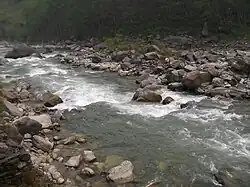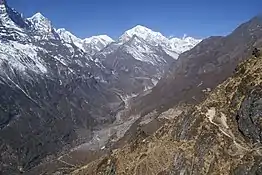| Bhote Koshi / Poiqu | |
|---|---|
 Bhote Koshi near the Tibetan border during dry season | |
| Physical characteristics | |
| Source | |
| • location | Zhangzangbo Glacier, Tibet Autonomous Region |
| • elevation | 8,012 m (26,286 ft) |
| Mouth | |
• location | Sun Kosi near Balephi, Sindhupalchowk, Nepal |
• coordinates | 27°43′58″N 85°46′47″E / 27.73278°N 85.77972°E |
• elevation | 640 m (2,100 ft)[1] |
| Basin features | |
| River system | Koshi River |
| Poiqu | |||||||||
| Tibetan name | |||||||||
|---|---|---|---|---|---|---|---|---|---|
| Tibetan | བོད་ཆུ | ||||||||
| Literal meaning | river of Tibet | ||||||||
| |||||||||
| Chinese name | |||||||||
| Traditional Chinese | 波曲 | ||||||||
| |||||||||
| Matsang Tsangpo | |||||||||
| Tibetan name | |||||||||
|---|---|---|---|---|---|---|---|---|---|
| Tibetan | མ་གཙང་གཙང་པོ། | ||||||||
| |||||||||
| Chinese name | |||||||||
| Traditional Chinese | 麻章藏布 | ||||||||
| |||||||||
| Bhote Kosi | |||||||
|---|---|---|---|---|---|---|---|
| Traditional Chinese | 波特科西 | ||||||
| Simplified Chinese | 波特科西 | ||||||
| |||||||
| Nepali name | |||||||
| Nepali | भोटे कोशी | ||||||
Bhote Koshi in Nepal and Poiqu in Tibet (both names roughly mean "Tibetan river") is the name given to the upper course (main tributary) of the Sun Kosi river.[2][3] It is part of the Koshi River system in Nepal.[1]
Names and etymology
Bhote koshi is the Nepalese name (Nepali: भोटे कोशी, romanized: Bhōṭē kōśī). In Nepali language, the word "bhoṭe" or "bhoṭiyā" means Tibetan;[4] and the word "kosi" means river.[5] As such, the name is not unique, the western tributary of the upper Dudh Koshi is also called Bhote Koshi.[6]
Poiqu (Tibetan: བོད་ཆུ) is the common name for the river on the Chinese side.[7][8] It is also transliterated as Boqu via Chinese (Chinese: 波曲).[9] and as Po Chu by early 1990s Everest expeditions.[10] This name means "River of Tibet."[11] This too is not a unique name, as it is also ascribed to Yarlung Tsangpo. The formal name of the river in Tibetan is Matsang Tsangpo (Tibetan: མ་གཙང་གཙང་པོ།).[8][7]
River course

The headwaters of the Poiqu and Bhote-Sun Koshi River are located at the Zhangzangbo Glacier in Tibet.[12] The river flows out of the Lumi Chimi lake. When entering Nepal, it is called the Bhote Koshi. Further downstream, from the village of Bahrabise onwards, it is called the Sun Koshi.[1]
Hazards
In July 1981, a sudden ice avalanche caused a Glacial Lake Outburst Flood in the moraine-dammed Zhangzangbu-Cho Lake in the headwaters of the Bhote Koshi. The ensuing debris flow destroyed bridges, and sections of both the Arniko and the Nepal–China highways.[13]
Tourism and sports
The Bhote Kosi is used for both rafting and kayaking. It is the steepest river rafted in Nepal, with a gradient of 15 m per km. Bungee jumping or swinging over the Bhote Kosi has been described as the ‘ultimate experience’.[14]
The river carves a steep and direct drop at the top that gradually eases to more placid streams and calmer pools with a 46-km run at the Lamosunga dam. The rapids are class IV-V at high flow, and III at lower levels. The river is steep and continuous with one rapid leading into another.
References
- 1 2 3 Shrestha, A. B., Eriksson, M., Mool, P., Ghimire, P., Mishra, B., & Khanal, N. R. (2010). Glacial lake outburst flood risk assessment of Sun Koshi basin, Nepal. Geomatics, Natural Hazards and Risk 1(2): 157–169.
- ↑ Yamada, T; Sharma, C.K. (1993). "Glacier lakes and outburst floods in the Nepal Himalaya" (PDF). International Association of Hydrological Sciences. pp. 319–330. Archived from the original (PDF) on 20 March 2020. Retrieved 18 February 2022.
- ↑ Su, Pengcheng; Liu, Jingjing; Li, Yong; Liu, Wei; Wang, Yang; Ma, Chun; Li, Qimin (11 November 2021). "Changes in glacial lakes in the Poiqu River basin in the central Himalayas". Hydrology and Earth System Sciences. 25 (11): 5879–5903. doi:10.5194/hess-25-5879-2021. eISSN 1607-7938.
the Poiqu River (Bhote Koshi River), a tributary of the Sun Koshi River ... The Poiqu River (known as the Bhotekoshi River in Nepal) is the boundary river between China and Nepal
- ↑ Turner, R. L. (1931). "bhote". A Comparative and Etymological Dictionary of the Nepali Language. K. Paul, Trench, Trubner: London.
- ↑ Turner, R. L. (1931). "kosi". A Comparative and Etymological Dictionary of the Nepali Language. K. Paul, Trench, Trubner: London.
- ↑ Kattelmann, R. (2003). Glacial lake outburst floods in the Nepal Himalaya: a manageable hazard? Natural Hazards 28(1): 145–154.
- 1 2 "Xigazê Prefecture-Level City". Institute of the Estonian Language. 2018-06-03. Retrieved 18 February 2022.
- 1 2 Sciences, Humanities and Arts Network of Technological Initiatives (2016). "Matsang Stream". SHANTI Place Dictionary. University of Virginia. Retrieved 18 February 2022.
- ↑ Xu, Daoming (December 1988). "Characteristics of debris flow caused by outburst of glacial lake in Boqu river, Xizang, China, 1981". GeoJournal. 17 (4). doi:10.1007/BF00209443. eISSN 1572-9893. ISSN 0343-2521. S2CID 128613506.
- ↑ Charles Howard-Bury; George Mallory (1922). Mount Everest: The Reconnaissance, 1921. Longmans, Green and Company. p. 323. ISBN 978-1-977876-60-7. OCLC 1124314824.
in the valley of the Po Chu or Bhotia Kosi R.
- ↑ Royal Asiatic Society of Great Britain and Ireland (1891). Journal of the Royal Asiatic Society of Great Britain & Ireland. Cambridge University Press for the Royal Asiatic Society. p. 256. OCLC 1764574.
Po chu probably for Bod ch'u or "River of Tibet." It is generally call in Chinese Ya-lu ts'ang-pu chiang (Yaru ts'angpo in Tibetan).
- ↑ Bajracharya, S. R., Mool, P. K., Shrestha, B. R. (2006). The impact of global warming on the glaciers of the Himalaya. Pages 231–242 in: Proceedings of the International Symposium on Geodisasters, Infrastructure Management and Protection of World Heritage Sites. Nepal Engineering College, Ehime College and National Society for Earthquake Technology Nepal.
- ↑ Mool, P. K.; Joshi, S. P.; Bajracharya, S. R. (2001). Glacial Lake Outburst Floods and Damage in the Country. Pages 121–136 in: Inventory of Glaciers, Glacial Lakes and Glacial Lake Outburst Floods: Monitoring and Early Warning Systems in the Hindu Kush-Himalayan Region, Nepal. International Centre for Integrated Mountain Development, Kathmandu.
- ↑ Bindloss, J. (2010). "Bungee Jumping". Nepal. Lonely Planet. p. 87. ISBN 9781742203614. Retrieved 2010-05-23.
External links
- Bhote Kosi River (Upper Sun Kosi), OpenStreetMap, retrieved 19 December 2021.
- Sun Kosi River, OpenStreetMap, retrieved 19 December 2021.
- Arun River, OpenStreetMap, retrieved 19 December 2021.
- Sapta Kosi River, OpenStreetMap, retrieved 19 December 2021.